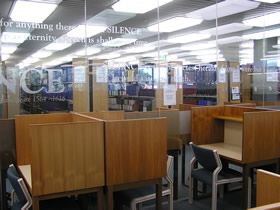
With the University providing an increasing number of courses online and offshore, the Library moved to a preference for electronic rather than print resources.The revised Collection Principles articulated in 2012 stated this unequivocally, noting that this approach allowed the Library ‘to provide equitable access to the collection to all Curtin students and staff regardless of the time or their location’. 10
Further, the shift to electronic journal databases and e-books enabled the Library, in common with other academic libraries, to provide access to significant collections of scholarly resources outside what was possible in the print-only environment.
‘Once, it was only the old-established universities, like Sydney or Melbourne or the University of Western Australia, which could afford to buy huge collections of books and journals. With the technological developments, it became simple and relatively inexpensive for Curtin [Library] to purchase new books and whole backsets of the leading journals and make them available to scholars. Technology led to equality.’11
The value of the Australian dollar fluctuated wildly across the decade 12 and the introduction of currency protection in 2006 provided some stability for collection development. 13 Acquisition budgets increased in dollar terms from $6.2 million in 2002 to $8.2 million in 2009 and then to $9.0 million in 2012.

